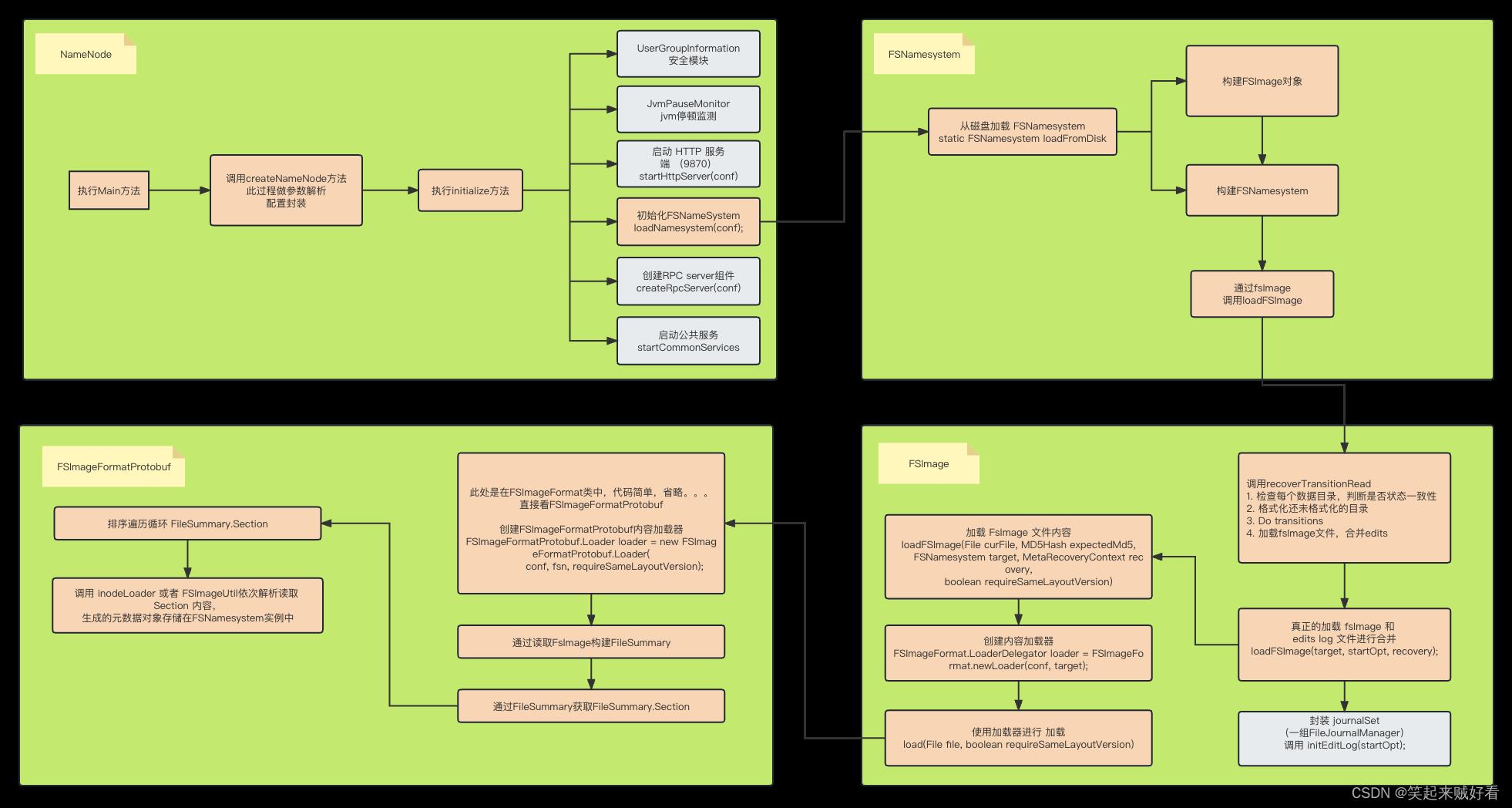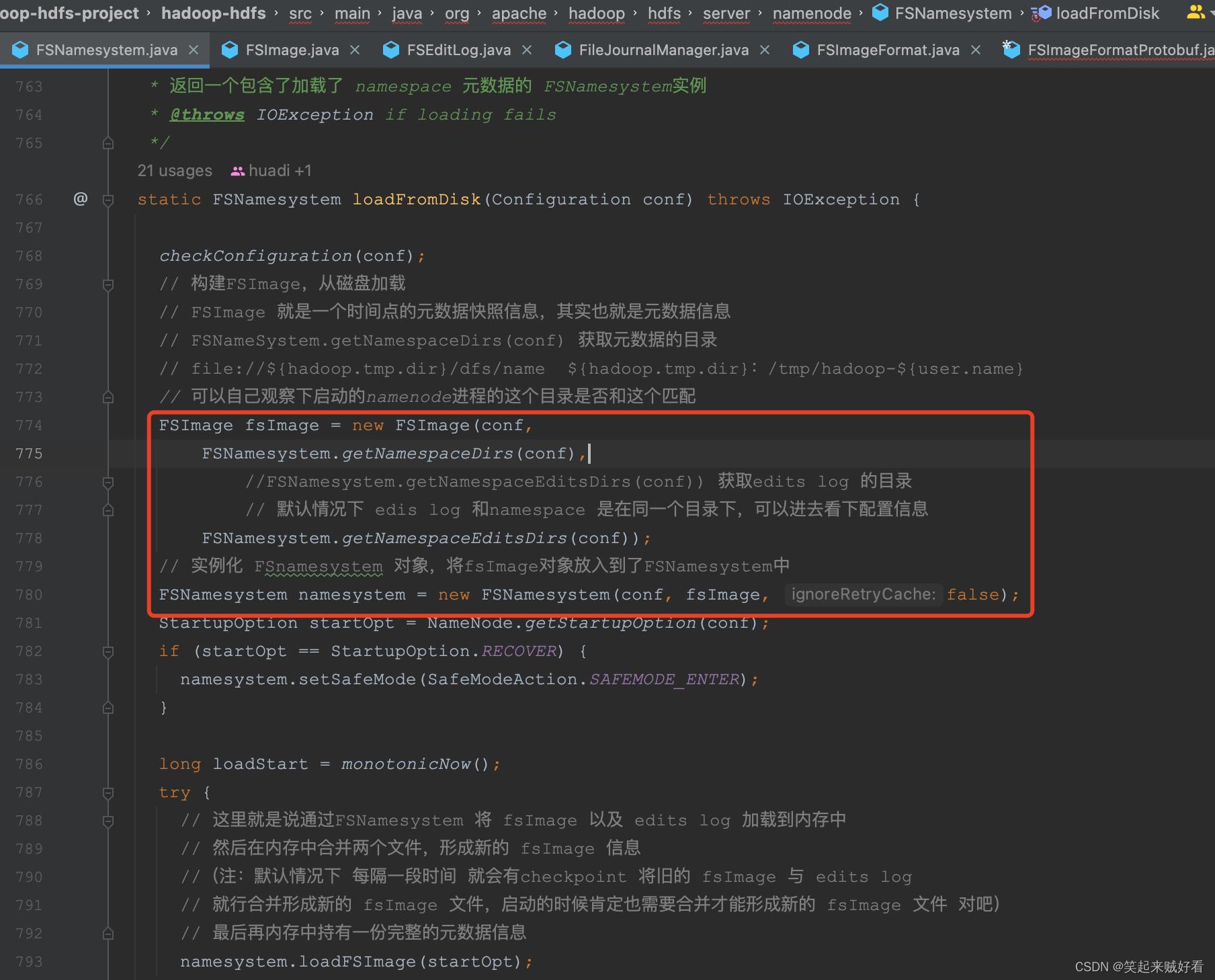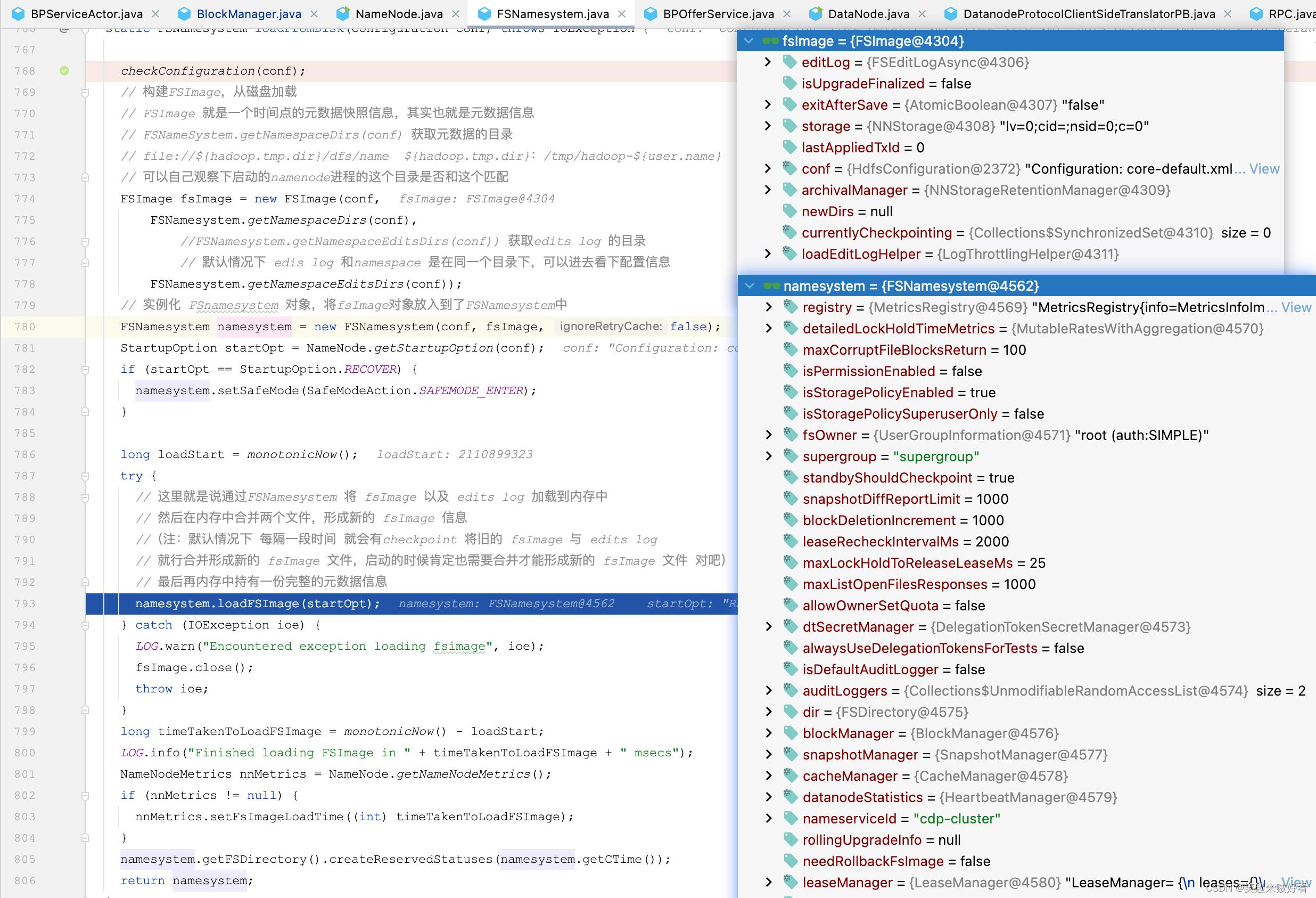大数据源码Hadoop源码解读 Namenode 启动加载FsImage的过程
Posted 笑起来贼好看
tags:
篇首语:本文由小常识网(cha138.com)小编为大家整理,主要介绍了大数据源码Hadoop源码解读 Namenode 启动加载FsImage的过程相关的知识,希望对你有一定的参考价值。
Namenode 启动
前言
NameNode是HDFS中负责元数据管理的组件,它保存着整个文件系统的元数据信息,并且充当着指挥调度DataNode的作用。NameNode不仅在内存中保存着文件系统元数据信息,还会定期将文件系统的元数据(文件目录树、文件/ 目录元信息) 持久化到本地 fsImage 文件中, 以防止Namenode掉电或者进程异常崩溃。
如果Namenode实时地将内存中的元数据同步到fsimage文件中, 将会非常消耗资源且造成Namenode运行缓慢。 所以Namenode会先将元数据的修改操作保存在editlog文件中, 然后定期合并fsimage和editlog文件

NameNode.main() // 入口函数
|——createNameNode(); // 通过new NameNode()进行实例化
|——initialize(); // 方法进行初始化操作
|——startHttpServer(); // 启动HttpServer
|——loadNamesystem(); // 加载元数据
|——createRpcServer(); // 创建并初始化rpc server实例
|——startCommonServices();
|——namesystem.startCommonServices(); // 启动一些磁盘检查、安全模式等一些后台服务及线程
|——new NameNodeResourceChecker(); // 实例化一个NameNodeResourceChecker并准备出所有需要检查的磁盘路径
|——checkAvailableResources(); // 开始磁盘空间检查
|——NameNode.getStartupProgress(); // 获取StartupProgress实例用来获取NameNode各任务的启动信息
|——setBlockTotal(); // 设置所有的block,用于后面判断是否进入安全模式
|——blockManager.activate(); // 启动BlockManager里面的一堆关于block副本处理的后台线程
|——rpcServer.start(); // 启动rpcServer
|——join()
启动 Namenode 组件
启动脚本
bin/hdfs --daemon start namenode
上述脚本会 调用 org.apache.hadoop.hdfs.server.namenode.NameNode的main方法
public static void main(String argv[]) throws Exception
// ...省略
// 创建 namenode
NameNode namenode = createNameNode(argv, null);
// ...省略
创建 NameNode 的过程,先进行参数解析,判断是 format / rollback / bootstrapStandby 等等操作类型。然后依次执行改逻辑,本章节主要是正对NameNode的启动过程。
依次往下阅读 ,进入到 NameNode的构造函数中 调用 initialize(getConf());
Namenode.initialize
此方法主要做了如下事项:
- 配置安全相关的信息UserGroupInformation
- 启动 JvmPauseMonitor 检查
- 启动 HTTP 服务端 (9870)
- 初始化FSNameSystem 核心组件 ,加载镜像文件和编辑日志到内存
- 初始化rpc server 组件
- 启动 公共 服务
protected void initialize(Configuration conf) throws IOException
if (conf.get(HADOOP_USER_GROUP_METRICS_PERCENTILES_INTERVALS) == null)
String intervals = conf.get(DFS_METRICS_PERCENTILES_INTERVALS_KEY);
if (intervals != null)
conf.set(HADOOP_USER_GROUP_METRICS_PERCENTILES_INTERVALS,
intervals);
UserGroupInformation.setConfiguration(conf);
loginAsNameNodeUser(conf);
NameNode.initMetrics(conf, this.getRole());
StartupProgressMetrics.register(startupProgress);
pauseMonitor = new JvmPauseMonitor();
pauseMonitor.init(conf);
pauseMonitor.start();
metrics.getJvmMetrics().setPauseMonitor(pauseMonitor);
if (conf.getBoolean(DFS_NAMENODE_GC_TIME_MONITOR_ENABLE,
DFS_NAMENODE_GC_TIME_MONITOR_ENABLE_DEFAULT))
long observationWindow = conf.getTimeDuration(
DFS_NAMENODE_GC_TIME_MONITOR_OBSERVATION_WINDOW_MS,
DFS_NAMENODE_GC_TIME_MONITOR_OBSERVATION_WINDOW_MS_DEFAULT,
TimeUnit.MILLISECONDS);
long sleepInterval = conf.getTimeDuration(
DFS_NAMENODE_GC_TIME_MONITOR_SLEEP_INTERVAL_MS,
DFS_NAMENODE_GC_TIME_MONITOR_SLEEP_INTERVAL_MS_DEFAULT,
TimeUnit.MILLISECONDS);
gcTimeMonitor = new Builder().observationWindowMs(observationWindow)
.sleepIntervalMs(sleepInterval).build();
gcTimeMonitor.start();
metrics.getJvmMetrics().setGcTimeMonitor(gcTimeMonitor);
if (NamenodeRole.NAMENODE == role)
// 启动 HTTP 服务端 (9870)
startHttpServer(conf);
// 初始化FSNameSystem 核心组件 ,加载镜像文件和编辑日志到内存
loadNamesystem(conf);
startAliasMapServerIfNecessary(conf);
//初始化rpc server 组件
rpcServer = createRpcServer(conf);
initReconfigurableBackoffKey();
if (clientNamenodeAddress == null)
// This is expected for MiniDFSCluster. Set it now using
// the RPC server's bind address.
clientNamenodeAddress =
NetUtils.getHostPortString(getNameNodeAddress());
LOG.info("Clients are to use " + clientNamenodeAddress + " to access"
+ " this namenode/service.");
// 如果是NameNode 设置NameNodeAddress 以及 FsImage
if (NamenodeRole.NAMENODE == role)
httpServer.setNameNodeAddress(getNameNodeAddress());
httpServer.setFSImage(getFSImage());
if (levelDBAliasMapServer != null)
httpServer.setAliasMap(levelDBAliasMapServer.getAliasMap());
// 一些公共服务的初始化
startCommonServices(conf);
startMetricsLogger(conf);
FSNamesystem.loadFromDisk
接着会调用 FSNamesystem 静态方法 loadFromDisk 加载 元数据

static FSNamesystem loadFromDisk(Configuration conf) throws IOException
checkConfiguration(conf);
// 构建FSImage,从磁盘加载
// FSImage 就是一个时间点的元数据快照信息,其实也就是元数据信息
// FSNameSystem.getNamespaceDirs(conf) 获取元数据的目录
// file://$hadoop.tmp.dir/dfs/name $hadoop.tmp.dir:/tmp/hadoop-$user.name
// 可以自己观察下启动的namenode进程的这个目录是否和这个匹配
FSImage fsImage = new FSImage(conf,
FSNamesystem.getNamespaceDirs(conf),
//FSNamesystem.getNamespaceEditsDirs(conf)) 获取edits log 的目录
// 默认情况下 edis log 和namespace 是在同一个目录下,可以进去看下配置信息
FSNamesystem.getNamespaceEditsDirs(conf));
// 实例化 FSnamesystem 对象,将fsImage对象放入到了FSNamesystem中
FSNamesystem namesystem = new FSNamesystem(conf, fsImage, false);
StartupOption startOpt = NameNode.getStartupOption(conf);
if (startOpt == StartupOption.RECOVER)
namesystem.setSafeMode(SafeModeAction.SAFEMODE_ENTER);
long loadStart = monotonicNow();
try
// 这里就是说通过FSNamesystem 将 fsImage 以及 edits log 加载到内存中
// 然后在内存中合并两个文件,形成新的 fsImage 信息
//(注:默认情况下 每隔一段时间 就会有checkpoint 将旧的 fsImage 与 edits log
// 就行合并形成新的 fsImage 文件,启动的时候肯定也需要合并才能形成新的 fsImage 文件 对吧)
// 最后再内存中持有一份完整的元数据信息
namesystem.loadFSImage(startOpt);
catch (IOException ioe)
LOG.warn("Encountered exception loading fsimage", ioe);
fsImage.close();
throw ioe;
long timeTakenToLoadFSImage = monotonicNow() - loadStart;
LOG.info("Finished loading FSImage in " + timeTakenToLoadFSImage + " msecs");
NameNodeMetrics nnMetrics = NameNode.getNameNodeMetrics();
if (nnMetrics != null)
nnMetrics.setFsImageLoadTime((int) timeTakenToLoadFSImage);
namesystem.getFSDirectory().createReservedStatuses(namesystem.getCTime());
return namesystem;
内存结构

FSNameSystem这里采用了门面模式,自己不负责具体的加载逻辑,交给FsImage去干活。
继续看FsImage.recoverTransitionRead(StartupOption startOpt, FSNamesystem target,MetaRecoveryContext recovery)
FsImage.recoverTransitionRead
主要做了四件事:
- 检查每个数据目录,判断是否状态一致性
- Format unformatted dirs. 格式化未格式的目录
- Do transitions 转换操作
- 真正的加载 fsImage 和 edits log 文件进行合并
/**
* Analyze storage directories.
* Recover from previous transitions if required.
* Perform fs state transition if necessary depending on the namespace info.
* Read storage info.
* 分析存储的目录 就是存储 fsImage 以及 edits log 的目录
* 从以前的状态恢复
* 根据元信息 判断是否执行fs状态的转换
* 读取存储的信息
* 大概意思就是如果以前有 fsImage 和 edits log 就从文件信息中加载出来 并进行恢复
*
* @throws IOException
* @return true if the image needs to be saved or false otherwise
*/
boolean recoverTransitionRead(StartupOption startOpt, FSNamesystem target,
MetaRecoveryContext recovery)
throws IOException
assert startOpt != StartupOption.FORMAT :
"NameNode formatting should be performed before reading the image";
// 获取fsImage 文件资源地址 其实也就是目录
Collection<URI> imageDirs = storage.getImageDirectories();
// 获取edits log 目录
Collection<URI> editsDirs = editLog.getEditURIs();
// none of the data dirs exist
if((imageDirs.size() == 0 || editsDirs.size() == 0)
&& startOpt != StartupOption.IMPORT)
throw new IOException(
"All specified directories are not accessible or do not exist.");
// 1. For each data directory calculate its state and
// check whether all is consistent before transitioning.
// 检查每个数据目录,判断是否状态一致性
// 进行数据恢复 里面就是对一些之前停机的时候 更新 回滚 新增数据的恢复操作
Map<StorageDirectory, StorageState> dataDirStates =
new HashMap<StorageDirectory, StorageState>();
boolean isFormatted = recoverStorageDirs(startOpt, storage, dataDirStates);
if (LOG.isTraceEnabled())
LOG.trace("Data dir states:\\n " +
Joiner.on("\\n ").withKeyValueSeparator(": ")
.join(dataDirStates));
if (!isFormatted && startOpt != StartupOption.ROLLBACK
&& startOpt != StartupOption.IMPORT)
throw new IOException("NameNode is not formatted.");
int layoutVersion = storage.getLayoutVersion();
if (startOpt == StartupOption.METADATAVERSION)
System.out.println("HDFS Image Version: " + layoutVersion);
System.out.println("Software format version: " +
HdfsServerConstants.NAMENODE_LAYOUT_VERSION);
return false;
if (layoutVersion < Storage.LAST_PRE_UPGRADE_LAYOUT_VERSION)
NNStorage.checkVersionUpgradable(storage.getLayoutVersion());
if (startOpt != StartupOption.UPGRADE
&& startOpt != StartupOption.UPGRADEONLY
&& !RollingUpgradeStartupOption.STARTED.matches(startOpt)
&& layoutVersion < Storage.LAST_PRE_UPGRADE_LAYOUT_VERSION
&& layoutVersion != HdfsServerConstants.NAMENODE_LAYOUT_VERSION)
throw new IOException(
"\\nFile system image contains an old layout version "
+ storage.getLayoutVersion() + ".\\nAn upgrade to version "
+ HdfsServerConstants.NAMENODE_LAYOUT_VERSION + " is required.\\n"
+ "Please restart NameNode with the \\""
+ RollingUpgradeStartupOption.STARTED.getOptionString()
+ "\\" option if a rolling upgrade is already started;"
+ " or restart NameNode with the \\""
+ StartupOption.UPGRADE.getName() + "\\" option to start"
+ " a new upgrade.");
// 执行一些启动选项以及一些二更操作
storage.processStartupOptionsForUpgrade(startOpt, layoutVersion);
// 2. Format unformatted dirs.
for (Iterator<StorageDirectory> it = storage.dirIterator(); it.hasNext();)
StorageDirectory sd = it.next();
StorageState curState = dataDirStates.get(sd);
switch(curState)
case NON_EXISTENT:
throw new IOException(StorageState.NON_EXISTENT +
" state cannot be here");
case NOT_FORMATTED:
// Create a dir structure, but not the VERSION file. The presence of
// VERSION is checked in the inspector's needToSave() method and
// saveNamespace is triggered if it is absent. This will bring
// the storage state uptodate along with a new VERSION file.
// If HA is enabled, NNs start up as standby so saveNamespace is not
// triggered.
LOG.info("Storage directory " + sd.getRoot() + " is not formatted.");
LOG.info("Formatting ...");
sd.clearDirectory(); // create empty current dir
// For non-HA, no further action is needed here, as saveNamespace will
// take care of the rest.
if (!target.isHaEnabled())
continue;
// If HA is enabled, save the dirs to create a version file later when
// a checkpoint image is saved.
if (newDirs == null)
newDirs = new HashSet<StorageDirectory>();
newDirs.add(sd);
break;
default:
break;
// 3. Do transitions
switch(startOpt)
case UPGRADE:
case UPGRADEONLY:
doUpgrade(target);
return false; // upgrade saved image already
case IMPORT:
doImportCheckpoint(target);
return false; // import checkpoint saved image already
case ROLLBACK:
throw new AssertionError("Rollback is now a standalone command, " +
"NameNode should not be starting with this option.");
case REGULAR:
default:
// just load the image
// 真正的加载 fsImage 和 edits log 文件进行合并
return loadFSImage(target, startOpt, recovery);
因为FsImage load重载比较多,故直接到关键步骤。
此方法中判断是否支持 md5 加密
/**
*
* 这里面就不仔细去详细的跟到文件加载了,
* loadFSImage()方法就是最终加载文件的方法
* @param target
* @param recovery
* @param imageFile
* @param startupOption
* @throws IOException
*/
void loadFSImageFile(FSNamesystem target, MetaRecoveryContext recovery,
FSImageFile imageFile, StartupOption startupOption) throws IOException
LOG.info("Planning to load image: " + imageFile);
StorageDirectory sdForProperties = imageFile.sd;
storage.readProperties(sdForProperties, startupOption);
if (NameNodeLayoutVersion.supports(
LayoutVersion.Feature.TXID_BASED_LAYOUT, getLayoutVersion()))
// For txid-based layout, we should have a .md5 file
// next to the image file
boolean isRollingRollback = RollingUpgradeStartupOption.ROLLBACK
.matches(startupOption);
loadFSImage(imageFile.getFile(), target, recovery, isRollingRollback);
else if (NameNodeLayoutVersion.supports(
LayoutVersion.Feature.FSIMAGE_CHECKSUM, getLayoutVersion()))
// In 0.22, we have the checksum stored in the VERSION file.
String md5 = storage.getDeprecatedProperty(
NNStorage.DEPRECATED_MESSAGE_DIGEST_PROPERTY);
if (md5 == null)
throw new InconsistentFSStateException(sdForProperties.getRoot(),
"Message digest property " +
NNStorage.DEPRECATED_MESSAGE_DIGEST_PROPERTY +
" not set for storage directory " + sdForProperties.getRoot());
loadFSImage(imageFile.getFile(), new MD5Hash(md5), target, recovery,
false);
else
// We don't have any record of the md5sum
loadFSImage(imageFile.getFile(), null, target, recovery, false);
调用 FSImageFormat的LoaderDelegator进行加载fsImage文件
FSImageFormat.load
private void loadFSImage(File curFile, MD5Hash expectedMd5,
FSNamesystem target, MetaRecoveryContext recovery,
boolean requireSameLayoutVersion) throws IOException
// BlockPoolId is required when the FsImageLoader loads the rolling upgrade
// information. Make sure the ID is properly set.
target.setBlockPoolId(this.getBlockPoolID());
// 一个持有FSNamesystem 以及 conf 对象的 loader,加载器
FSImageFormat.LoaderDelegator loader = FSImageFormat.newLoader(conf, target);
loader.load(curFile, requireSameLayoutVersion);
// Check that the image digest we loaded matches up with what
// we expected
MD5Hash readImageMd5 = loader.getLoadedImageMd5();
if (expectedMd5 != null &&
!expecte以上是关于大数据源码Hadoop源码解读 Namenode 启动加载FsImage的过程的主要内容,如果未能解决你的问题,请参考以下文章